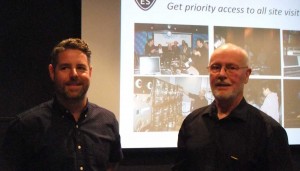Audio Digitisation at the NFSA
More for all – increasing capacity and capability.
On Monday November 16th, 19 members and visitors gathered at the SAE Institute in South Melbourne to hear Ross Garrett of the National Film and Sound Archive, Canberra tell us about their major project of updating the systems used for digitisation of their sound assets.
He described the previous system based on multiple AES-3 connections to the digital audio workstations (DAWs) in each of their seven studios, with a complex analogue/digital patching system to route the individual AES-3 feeds to the desired destinations.
He covered the current system’s inadequacy in digital synchronization and patching functionality, as well as the imperative to replace the aging hardware.
He then outlined the infrastructure review they carried out with the goals of providing information on future-proofing the systems, enabling new workflows, and decentralizing tasks to maximize use of resources.
He explained that the review recommended an infrastructure upgrade comprising new Analog to Digital Converters, DAWs, a multi-channel routing system and batch processing device.
He then described the NFSA audio collection, which comprises 160,000 items of which only 16% are currently digitised, and a target of 35,000 items to be digitised in the next ten years. He explained that at their current rate they would not achieve the target, with the unfortunate effect that many items would perish before being digitised.
His point was that they need to increase their throughput and planned on achieving this by creating more digital copies in less time using multi-track tapes & multiple-ingest, as well as using batch-process techniques for restoration work. This was achieved by using 8 channel converters, interconnecting via a digital MADI network and using a standalone device for batch processing restoration tasks.
Ross then described in detail the hardware employed, and the interconnection topology.
The concept and practice of “multiple ingest” was explained, and demonstrated with a video of a workstation running a multiple-ingest session. Multiple-ingest permits one studio to be ingesting two or more items simultaneously with the monitoring automatically cycling through the multiple feeds on a regular and frequent basis for Quality Assurance purposes. Restoration batch processing, based on a Cedar device was also explained.
He then described the refit process, emphasising that they were able to keep the downtime to a minimum by keeping the old system running and building the new system in parallel.
Following the presentation, a long Q&A session covering a wide range of NFSA topics, techniques, and technologies was indicative of the interest of the audience in the subject matter.
We thank Ross for travelling from Canberra to Melbourne to present to us on this fascinating subject.
Ross’ presentation slides in PDF format can be viewed or downloaded here
An audio recording of Ross’ presentation can be played or downloaded here
Thanks to Graham Haynes and his trusty Tascam for the audio recording.
Special thanks to the SAE Institute for providing the venue for our meetings.

